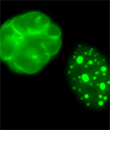Return to Online
Education Kit
|
 |
 |
 Previous Event | Next Event Previous Event | Next Event 
2003: Premature Aging Gene Identified

A team of researchers led by the National Human Genome Research Institute announced the discovery of a gene associated with a rare genetic disease that leads to premature aging. Hutchinson-Gilford progeria syndrome (HGPS), commonly called progeria, affects one in 8 million live births worldwide. The disorder has no diagnostic test or treatment. Children with the disease appear to age at a rate 5 to 10 times faster than normal.
Researchers found that the most common cause of progeria is a single base substitution in a gene located on chromosome 1. Now that the causative gene has been identified, a DNA-based test for progeria is available at five clinical laboratories [genetests.org]. This allows doctors to diagnose or rule out progeria in newborns much earlier than waiting for visible symptoms to appear.
More Information
References:
Eriksson, M., Brown, W.T., Gordon, L.B., Glynn, M.W., Singer, J., Scott, L., Erdos, M.R., Robbins, C.M., Moses, T.Y., Berglund, P., Dutra, A., Pak, E., Durkin, S., Boehnke, M., Glover, T.W., Collins, F.S. Recurrent de novo point mutations in lamin A cause Hutchinson-Gilford progeria syndrome. Nature, 423: 293-298. 2003. [PubMed]
Capell, B.C., Erdos, M.R., Masigan, J.P., Fiordalisis, J.J., Varga, R., Conneely, K.N., Gordon, L.B., Der, C.J., Cox, A.D., Collins, F.S. Inhibiting farnesylation of progerin prevents the characteristic nuclear blebbing of Hutchinson-Gilford progeria syndrome. Proc. Natl. Acad. Sci. USA, 102(36): 12879-12884. [PubMed]
 Previous Event | Next Event Previous Event | Next Event 
Last Reviewed: April 17, 2008
|

